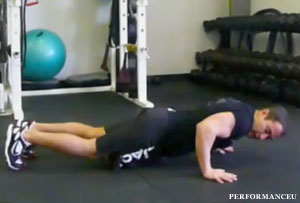Not many of us love the push-up. Sure, it’s relatively safe and effective, but let’s face it, it's kind of boring. It's something we did in P.E. class.
But what if you realized that the push-up would not only help you get a stronger upper body, but also a stronger midsection?
It's true. The push-up incorporates the stabilization muscles of your core, combining an upper-body pushing movement with a plank -- one of the best and most basic exercises for your midsection.
In fact, according to Nick Tumminello, trainer and owner and operator of the Performance University gym in Baltimore, Md., the push-up can effectively replace the sit-up.

“The push-up is basically a plank position," Tumminello says, "so it’s actually a great abdominal exercise and there’s no reason to do planks if you can do (a significant number of) push-ups."
Push-ups are a higher value plank. You’re not only strengthening your abdominals by holding them still while gravity’s trying to push your hips towards the ground, but you’re also strengthening your upper-body pushing muscles: your chest, shoulders and triceps.”
What else can a push-up do for you?
For many men, the bench press is a temptress -- the key to getting a big chest and, sometimes, an inflated ego.
“How much can you bench?” is ingrained in our fitness conversations because of the tangibility of numerous 45-lb. plates on the barbell. “How many push-ups can you do?” is not, however, even though push-ups are a much better indicator of relative strength, since you’re forced to push the mass of your body against the forces of gravity and stabilize your core.
For many women, a full push-up is a tease, a noble fitness goal that’s rarely achieved despite countless sets of knee pushups and other push-up variations.
“I have seen women who can hammer out forty plus kneeling push-ups who still can’t do one regular push-up," Tumminello says. "I’ve never trained a female who can bang out forty plus or even ten plus incline push-ups at about a bench height and not be able to hammer out at least one or two pushups from the floor."
So what's the best way for both men and women to perfect the push-up? Here are some tips -- no As-Seen-On-TV equipment needed:
-- If you can only do a handful of push-ups, start with your hands on a bench and your body in a straight line from your head to your feet. As the number of push-ups you can do with your hands on a bench improves, you can move to an aerobic step and decrease the height of the step.
-- If you find your midsection sagging towards the floor before your upper body gets tired, Tumminello recommends focusing on plank and other core stability exercises to help you stay stable.
-- When doing push-ups, either from the floor or from a bench or step, don’t try to form a “T” with your upper arms. Tuck your elbows towards your midsection at roughly a 45-degree angle. “Not only does (having your elbows flared to 90 degrees) make the exercise significantly tougher on you," Tumminello says, "but it can be a lot tougher on your shoulder and your elbow joints as well."
-- At all times, keep your wrists should directly underneath your elbows. Your forearm should be perpendicular to the ground at all times, like a table leg.
-- Open your hands up and angle your fingers slightly outward. “If you turn your hands outwards," Tumminello says, "it actually starts to incorporate your lat muscles and some more muscles in your shoulders. So not only do you have more horsepower behind the push-up, which helps increase your push-up strength, but now you actually have more muscles working to stabilize your joints as well."
For most of us, push-ups are a last resort -- what we do when we can't get to the gym. But maybe the last resort should actually be first.




